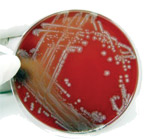
Disease-causing microbes such as these, shown growing in a lab dish, may one day be silenced using a new plastic-like material that blocks the chemical signals bacteria use to communicate.
The quest to develop highly reliable osseointegrated prostheses has been a long and arduous one. One of the main barriers to their safety has been users’ risk of bacterial infections, in which microorganisms travel up the shaft of the titanium-rod implant, form a biofilm, and infect the bone, potentially causing serious side effects, including systemic infections or the need for higher-level amputation. Rigorous cleaning protocols and development of trabecular metal implants have contributed to osseointegration’s potential, but users’ infection rates still hover around 10 percent, according to Robert Hugate, MD, of Colorado Limb Consultants, Denver, Colorado. (Editor’s note: Please see also “Osseointegration: Infection Solutions.”)
Now, a discovery about the nature of bacterial virulence may lead to prosthetic implants that can prevent the formation of biofilms and stop bacteria from becoming virulent. In 2002, researchers led by Bonnie Bassler, PhD, at Princeton University, New Jersey, discovered quorum sensing (QS), the method by which groups of bacteria sense how many of their species are in an environment and then determine when it’s time to become virulent, form biofilms, or undertake other group activities. Now, a team led by Elena Piletska, PhD, of Cranfield University, Bedfordshire, England, has created polymers based on this discovery. The signal molecule-sequestering polymers (SSPs) sequester the hormonal molecules that bacteria use for QS, preventing the bacteria from forming biofilms.
“We are developing a new solution for attenuation of QS, which involves selective sequestering of the signal molecules using computationally designed synthetic polymers,” Piletska wrote in the journal Biomacromolecules.“In contrast to traditional antibiotic therapy, treatment with signal sequestering polymers (SSPs) is less likely to induce resistance in the exposed bacterial population because suppression of QS is nonlethal. It is also less likely that polymers will produce undesirable side effects compared to drugs…. SSPs can be fabricated in any form, including films and injection moldings, offering the chance to attenuate QS-regulated infections by coating surfaces that are susceptible to contamination and biofilm accumulation, for example, catheters, prosthetics, and so on.”




